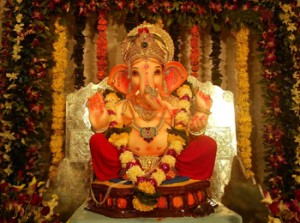Events
- Monday 19th Sep 2016
Tritiya Shraddha Chaturthi Shraddha Sankashti Chaturthi
Kutup (कुतुप) Muhurat = 11:56 to 12:44
Duration = 0 Hours 48 Mins
Rohina (रौहिण) Muhurat = 12:44 to 13:32
Duration = 0 Hours 48 Mins
Aparahna (अपराह्न) Kaal = 13:32 to 15:57
Duration = 2 Hours 24 Mins
Tritiya Tithi Begins = 18:21 on 18/Sep/2016
Tritiya Tithi Ends = 15:06 on 19/Sep/2016
2016 Tritiya Shraddha
Tritiya Shraddha is done for those family members died on Tritiya Tithi, including both Shukla and Krishna Paksha Tritiya. Tritiya Shraddha is also known as Teej Shraddha. Pitru Paksha Shraddhas are Parvan Shraddhas and auspicious time to perform them is either Kutup Muhurat and Rohina etc. Muhurat after that till Aparahna Kala gets over. Tarpan is done at the end of the Shraddha.
Auspicious Shraddha Timings
Kutup (कुतुप) Muhurat = 11:56 to 12:44
Duration = 0 Hours 48 Mins
Rohina (रौहिण) Muhurat = 12:44 to 13:32
Duration = 0 Hours 48 Mins
Aparahna (अपराह्न) Kaal = 13:32 to 15:57
Duration = 2 Hours 24 Mins
Chaturthi Tithi Begins = 15:06 on 19/Sep/2016
Chaturthi Tithi Ends = 11:57 on 20/Sep/2016
Panchang for Chaturthi Shraddha Day
Note - 24-hour clock with local time of Ujjain & DST adjusted for all Muhurat timings (if applicable)
2016 Chaturthi Shraddha
Chaturthi Shraddha is done for those deceased family members who died on Chaturthi Tithi, including both Shukla and Krishna Paksha Chaturthi. Chaturthi Shraddha is also known as Chauth Shraddha.
Pitru Paksha Shraddhas are Parvan Shraddhas(पार्वण श्राद्ध) and auspicious time to perform them is either Kutup Muhurat and Rohina etc. Muhurat after that till Aparahna Kala gets over. Tarpan (तर्पण) is done at the end of the Shraddha.
Sankashti Chaturthi
Each lunar month in Hindu calendar has two Chaturthi Tithis. The one after Purnimasi or full moon during Krishna Paksha is known as Sankashti Chaturthi and the one after Amavasya or new moon during Shukla Paksha is known as Vinayaka Chaturthi. Although Sankashti Chaturthi fasting is done every month but the most significant Sankashti Chaturthi falls in month of Magha according to Purnimant School and in month of Paush according to Amavasyant School. If Sankashti Chaturthi falls on Tuesday it is called Angarki Chaturthi and it is considered highly auspicious. Sankashti Chaturthi fast is mostly observed in Western and Southern India especially in Maharashtra and Tamil Nadu.Devotees of Lord Ganesha keep fast from sunrise to moonrise on Sankashti Chaturthi. Sankashti means deliverance during troubled times. Lord Ganesha, the supreme lord of intelligence, symbolizes the remover of all obstacles. Hence it is believed that one can get rid of all obstacles by observing this fast. The fast is supposed to be strict and only fruit, roots (the part of a plant which is below ground) and vegetable products are supposed to be consumed. The staple Indian diet on Sankashti Chaturthi includes Sabudana Khichadi, potato and peanuts. Devotees break the fast at night after sighting of the moon. In North India Sankashti Chaturthi during Magha month is known as Sakat Chauth. Sankashti Chaturthi is also known as Ganesh Sankatahara or Sankatahara Chaturthi among Tamil Hindus. It is important to understand that fasting day for Sankashti Chaturthi might differ for two cities even if those cities are within same Indian state. Fasting for Sankashti Chaturthi depends on moonrise and it is observed on the day when there is moonrise while Chaturthi Tithi is prevailing. Hence Sankashti Chaturthi fasting might be observed on Tritiya Tithi i.e. one day before Chaturthi Tithi. As moonrise time is different for all cities it is important to refer Hindu calendar like this website which lists location based Sankashti Chaturthi days. As generating location based dates are time consuming most sources ignore this fact and publish single list for all Indian cities.
